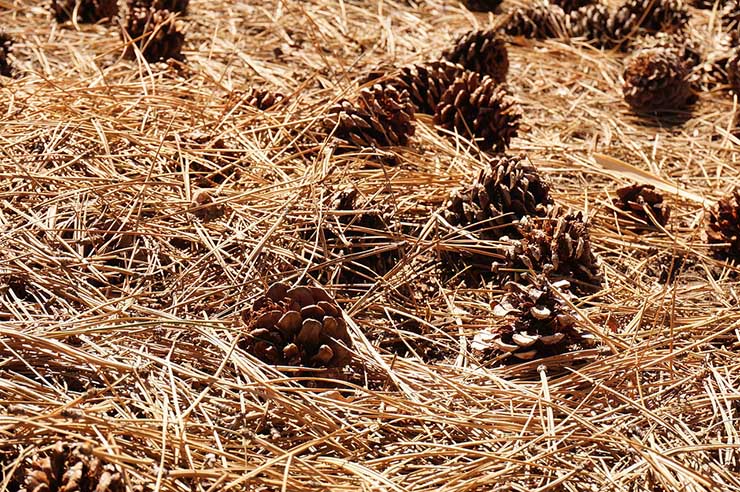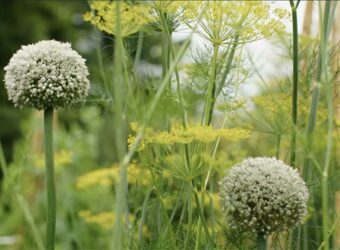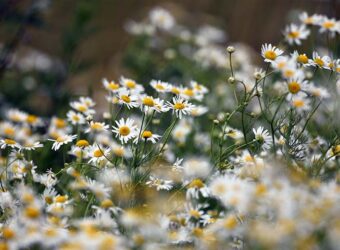Every Extension service recommends using mulch around trees, shrubs, and in landscape beds. However, there are so many mulches you may not know which one to choose. This guide discusses pine straw mulch and how and when to use it.
What Is Pine Straw Mulch?
Pine straw mulch is made from the needles of Long Leaf and Slash pine trees after they are shed by the tree. In many cases, the pine trees are being grown for lumber, and the pine straw is gathered as an additional product from the trees.
Pros and Cons of Pine Straw Mulch
Pine straw mulch, like anything, has good and bad qualities. Here are the most important ones.
Pros
Maintains Soil Temperature
Pine straw, like any mulch, helps keep the soil cool in the winter and warm in the summer. It insulates the soil, and your plant’s roots, from rapid temperature changes. In the spring, it may slow the soil warm-up, so moving it until the soil is warm may be necessary. You can just wait longer, however, and the soil will warm up on its own.
Conserves Water
Pine straw keeps the wind from blowing across the soil and drying it out. The mulch also slows down evaporation. However, the straw has air pockets that allow it to dry after a rain, so your plant’s roots don’t rot.
Encourages Water to Absorb in the Soil
Pine straw does not become compacted and is not water resistant. The relatively open structure of the pine straw allows water to penetrate it easily, unlike some mulches. This allows the soil to stay moist and makes water available to the plant’s roots.
Reduces Erosion
Because pine straw mulch covers the soil, the wind cannot whip the soil away. In addition, pine straw cushions the soil, so the water does not gouge out channels in the soil. Now, in a flood, you will still have erosion, but it will be reduced otherwise.
Adds Organic Matter to the Soil
Pine straw decomposes slowly, but it does add organic matter to the soil when it does. Where hardwood mulch adds an inch of organic matter to the soil a year, pine straw adds maybe ½ inch of organic matter a year.
Reduces Weeds
Pine straw mulch should be three inches thick. At that depth, pine straw reduces the growth of weeds. However, pine straw that is less than three inches thick does not do a good job of blocking weeds.
Reduces Soil Borne Diseases
Many soil-borne diseases attack plants when the soil splashes onto the foliage during a rain or irrigation. Pine straw mulch covers the soil and helps prevent it from splashing on the plants. No soil on the foliage means less disease. In addition, the pine straw protects berries from the soil, so you do not have as much problem with rotting and with insects eating them.
Doesn’t Wash Away
Pine straw mulch needles interlock with each other so it does not float away or blow away. To facilitate that, wetting the mulch thoroughly after applying it will encourage the straw to lock.
Looks Nice
Pine straw looks nice. It is a pleasant reddish brown that contrasts nicely with the green plants.
Cons
Pine Needles Are Sharp
You need to wear gloves when handling pine needles as they are sharp. They do not make good paths if anyone will be walking barefoot on them. Otherwise, they can be used for paths.
Acidify Soil
Pine straw mulch will eventually acidify the soil where it is used. However, this takes several years. It isn’t a problem if the plants you use the pine straw around want acidic soil.
Fire Hazard
Just like pine bark, pine needles are a fire hazard. They should not be used in areas where fires are common. I would not use them against the house, either, just to be careful.
May Not Be Available
Pine straw may not be available, or may be very expensive if you do not live near an area where they are grown. Big box stores will ship them, but the shipping can cost as much as the pine straw.
Applying Pine Straw Mulch in the Garden: When to Use and Not to Use?
If available, pine straw is best used around acid-loving plants. It can be used in paths if no one will be going barefoot on the paths.
When Do I Apply Pine Straw Mulch?
I apply pine straw mulch when transplanting any acid-loving plant. In the spring, I add enough pine straw mulch to make a layer three inches deep. The new mulch replaces what decomposed during the last year. It also freshens the mulch and improves the appearance of your landscaped areas.
Pine mulch can be applied to any stage of a plant after it is four inches tall. If you wish to seed a landscape bed that has pine straw mulch on it, you must remove the mulch until the seeds grow and are four inches tall. Otherwise, the mulch will prevent your seeds from growing just as if they were weeds.
How to Apply Pine Straw Mulch to the Landscape?
I would confine using pine straw mulch to acid-loving plants. You can use it for other things, but after several years I think you will see alkaline-loving plants start to struggle.
Vegetable Garden
Tomatoes and most other vegetables and fruits need alkaline soil. While you can use pine straw once or twice, you will do better to use wheat straw or some other type of straw that is not acidic.
I use hardwood mulch in my garden. It adds organic matter as it decomposes, and I just move it out of the way when I am planting.
If you are looking to mulch your vegetable garden, read this article.
Flower Beds
Roses, azaleas, and other acid-loving plants are the ideal places to use pine straw mulch. Place it in a donut with the mulch at least an inch from the stem.
Spread the mulch out to the dripline or end of the flower bed. Do not let the mulch touch the stem, or it will cause a rotten place.
I would not place pine straw mulch around alkaline-loving plants. I would use hardwood mulch instead.
For more information about flower bed mulching, read this article.
Fruit Trees
I would not use pine straw mulch around fruit trees. Most fruit trees need alkaline soil. I would use hardwood mulch around them if you just have one or two. If you have an orchard, I would use a living mulch like white clover or another legume. The living mulch will choke out weeds and add nitrogen to the soil.
Berries
Blueberries and strawberries like acidic soil. Pine straw is ideal for them, especially strawberries. Spread the pine straw with an inch margin around the crown of the strawberry so you do not cause crown rot. The pine straw will protect the strawberries from the soil and reduce the number of critters that chew on them.
For blueberries, leave three inches between the mulch and the stems and extend the mulch out to the edge of the dripline.
Blackberries are not a fan of acidic soil, so I would use hardwood mulch around them.
Ornamental Trees and Shrubs
Trees and shrubs that like acidic soil, like Dogwoods, will appreciate pine mulch around them. Trees that prefer alkaline soil will not, so use hardwood mulch instead. Leave three inches between the trunk of the tree and the mulch, then extend the mulch to the drip line. Do the same thing for shrubs.
Landscape Paths
As mentioned, pine straw mulch makes nice, cushioned paths. However, the needles are sharp, and anyone who tries to walk the path barefoot will be sorry. I use a different mulch, such as hardwood mulch or an inorganic mulch like pebbles, for paths in my garden.
Where Do I Buy Pine Straw Mulch?
Pine straw mulch is usually sold in bales or in boxes of straw. It is widely available from Home Depot, Lowe’s, and Wal-Mart. Some nurseries may have pine straw mulch, especially if they are near an area that produces it. However, if you live in areas that do not produce pine straw, it can be very expensive, if you can even find it. Online sources are very expensive because the shipping may be as much as the pine straw. I found a bale for around $45 or a box for around $100 online. People who are a long way from a pine-producing area can do other things to make acid-loving plants happy, such as using an acidic fertilizer. Substitute hardwood mulch, wheat, or other grain straw for pine needle mulch if it is too expensive for you.
Some Good Pine Straw Mulch Options
Two companies that supply pine straw needles to the big box stores are USA Pine Needles and National Plant Network.
USA Pine Needles
USA Pine Needles is in Georgia. They harvest both long-leaf and slash-leaf pine trees in an environmentally sustainable manner. They deliver pine straw mulch throughout the United States.
National Plant Network
National Plant Network delivers plants and plant solutions to people throughout the United States. They deliver pine straw as part of their mission to get more plants to more people.
Final Verdict
Pine straw mulch is good for acid-loving plants. It will gradually acidify the soil over several years. If you use pine straw mulch around alkaline-loving plants, I believe they will do well initially but will gradually start struggling. I would use hardwood mulch around them instead of the pine straw mulch. Pine straw mulch may be hard to find if you live in an area that does not have pine trees. In this case, pine straw mulch can be very expensive.






